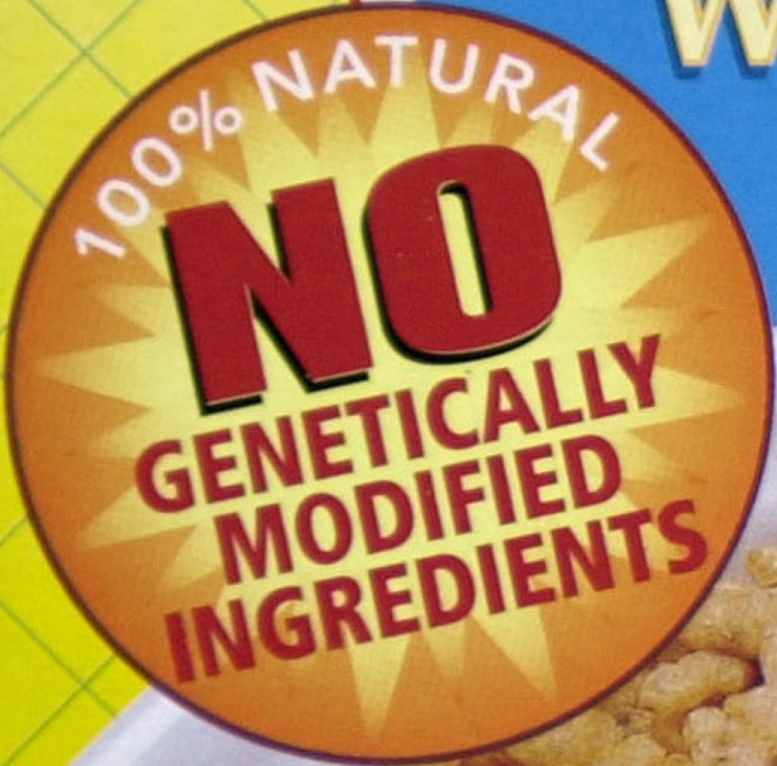The average kitchen contains dozens of labeled items: corn syrup that boasts it has 0g High Fructose Corn Syrup, crackers and cookies advertising no trans fats, maybe a package of grass-fed beef or organic peanut butter. Anyone reaching for a cigarette faces the granddaddy of all labels, the surgeon general’s warning on the box, the label that changed the cultural American landscape in the 1960s. Whether they be promises or cautions, labels are everywhere.
In 2014, Maine led the nation in passing legislation to add a new label to foods, one that would tell consumers if the item they are buying contains genetically modified organisms, or GMOs. Such labels are already mandatory in 64 countries. Maine’s law contained a “trigger clause” that meant it wouldn’t go into effect until five contiguous states had passed similar laws, but proponents of mandatory labeling don’t want to wait. In April they introduced a bill in the Maine Legislature that would overturn that clause.
Something as mild-sounding as “contains GMO ingredients” may not seem as controversial as dire words like “smoking causes lung cancer, heart disease, emphysema, and may complicate pregnancy.” But you wouldn’t know it from the expensive battles being waged at both state and federal levels over mandatory GMO labeling, including a bill winding its way through Congress that would pre-empt all states’ rights on the issue and render Maine’s GMO labeling law null and void.
A trip to the supermarket helps make clear why the issue is so fraught. From the produce section all the way over to dairy and everywhere in between, most of what you see contains GMO ingredients: from soy sauce to Coca-Cola, that ice cream on special, that pretty papaya or possibly even that sweet corn that speaks of summer nights. Are they in your breakfast cereals? Highly likely. GMO is the norm, not the exception. Just ask Denzel McGuire, executive vice president for government relations at the Grocery Manufacturers Association, the Washington, D.C., trade group that represents more than 300 food, beverage and consumer product companies.
“Seventy to 80 percent of food products contain GMOs,” McGuire said. The association is campaigning vigorously – and spending a lot of money – against mandatory labeling laws, citing cost as a primary factor. For her there are simply too many foods with GMO ingredients in the marketplace to label it all: “We label the exception, not the rule.”
Mandatory labeling, she said, is, or should be, “about nutrition, safety and health … not about opinion or emotion.”
CAN OF WORMS
That’s where the issue gets particularly interesting. The official position from the U.S. Food and Drug Administration is that there is no health or safety risk associated with genetically modified organisms (or genetically engineered, the other common term), no discernible differences between those foods and foods without GMO ingredients. Supporters of mandatory labeling point out that we’ve been eating GMO foods for only 20 years; it’s too soon to know. Opponents say 20 years is ample time.
But whether it’s opinion, emotion or just plain curiosity, polling indicates Americans want to know if their foods contain GMOs. Last week the group Just Label It released results of a new national Mellman poll saying 88 percent of respondents support mandatory labeling.
“That isn’t to say that 88 percent of them are going to change their eating habits,” said Gary Hirshberg, chairman of Just Label It (and also the chairman of Stonyfield Farm). He was calling from a cab, headed to Capitol Hill to lobby against the Safe and Accurate Food Labeling Act of 2015, introduced in March by U.S. Rep. Mike Pompeo, R-Kan. Like other labeling proponents, Hirshberg refers to it as the DARK act (Deny Americans the Right-to-Know).
“If you look at the history of fighting over sugar, fat, calories, industry is always opposed to disclosures because they don’t want to be told by the consumer what to do,” Hirshberg added. “But that is such a 20th century way of thinking. I cannot believe that these really large companies don’t see the real opportunity here, which is to say, ‘Hell yes, we want you to know.'”
McGuire said that organic manufacturers – Stonyfield is an organic yogurt company – are in the fight for financial reasons. “They want more people to buy their more-expensive food.”
Mandatory labeling, she said, would be used “to demonize GMOs. We have already seen this, even though they are completely safe.”
It’s worth considering the long and winding road traveled by other product labels. Once upon a time, trans fat was a term no one but scientists and doctors used. Trans fat, commonly appearing in food as partially hydrogenated oils, was common in foods for most of the 20th century and made many a batch of french fries crispy and convenient. Then in 1999, the FDA proposed labeling requirements for trans fats after scientists determined they were associated with health risks (including clogged arteries). The proposal crept along; among the petitions for a delay was one from the Grocery Manufacturers Association. The industry estimated the costs of removing trans fats at $8 billion. By 2005, a year before the FDA’s mandatory labeling was actually enforced, the Grocery Manufacturers Association reported that its members had voluntarily cut 73 percent of trans fats in their products. In 2013 the FDA said trans fats or partially hydrogenated oils could no longer be “generally recognized as safe” and proposed further reductions that would amount to a near ban. It’s 2015 and that final ruling is expected – soon.
The Center for Science in the Public Interest advocated for labeling of trans fats starting in 1993. It’s not involved with the GMO labeling effort because, as executive director Michael Jacobson said, foods made from genetically modified crops pose no health risk. (The group is, however, concerned about the environmental aspects of GMO farming.) “With trans fat, it is totally different,” Jacobson said. “It is inherently unsafe.”
But once, weren’t trans fats considered fine? Yes, Jacobson conceded. “It could happen with anything,” he said. “As science advances, our views change. But every scientific agency in the world is saying this stuff is safe.”
To eat, anyway.
THE GOLDEN EGG
The Grocery Manufacturers Association has successfully fought proposed labeling measures in California and Oregon. But it recently lost an appeal of a GMO labeling law in Vermont. While Maine’s law contained that “trigger clause,” Vermont’s law is due to go into effect in 2016 regardless of what other New England states are up to (Connecticut also passed a mandatory GMO labeling law with a trigger clause).
McGuire said the association wants a consistent policy. “We are so concerned about the 50-state patchwork and the confusion of that,” she said.
Demonizing might seem like a strong word for McGuire to use, but plenty of people distrust and fear GMO food on the grounds that it alters nature on a genetic level. Frankenfood, some call it. In Maine, groups like the Maine Organic Farmers and Gardeners Association, or MOFGA, lobbied hard for the mandatory labeling law. But the law passed because it had true bipartisan support. The more conservatively inclined Maine Farm Bureau, which had initially opposed it, came to support it, as did some right-leaning members of the Legislature who said they had no problem with GMO food or crops – of which Maine has few, less than 1 percent of the state’s total farmland is planted with GMO crops. What mattered to them, and to Gov. Paul LePage, was the public’s right to know.
But some oppose GMO foods for more sweeping environmental reasons. Genetically modified seeds produce bigger yields more consistently and in more challenging growing situations (like heat) because they have been altered to include resistance to pests, disease and weeds, as well as the chemicals used to treat those issues. The first major herbicide introduced in conjunction with GMO seeds was Monsanto’s glyphosate, commercially known as Roundup. The GMO seeds were Roundup-resistant. (Chemical/seed companies typically make and sell the pesticides that work with their patented GMO seeds.) Among the promises of Roundup resistance seeds – they’d require fewer pesticides.
Glyphosate killed weeds like nobody’s business – including milkweed, a key food for monarch butterflies, whose numbers are dwindling nationwide. Farmers loved it. “It was easy and forgiving,” said Charles Benbrook, a research professor at Washington State University’s Center for Sustaining Agriculture and Natural Resources and the author of a study linking increased pesticide use with GMOs. By spraying the same herbicide on their fields every year, the farmers inadvertently created a new problem: superweeds.
“It drives a shift in the community of weeds toward those that are less well controlled by glyphosate and also triggers the emergence of genetically resistant weeds,” Benbrook said. “What would your doctor say if every time you had any kind of flu or sickness you took the same antibiotic?” he added. “That is unfortunately what farmers have done.” By 2003, he said, farmers needed to add more herbicides, creating what Hirshberg and others call “the pesticide treadmill.” In 2012, Benbrook found that overall pesticide use was up by 404 million pounds between 1996, when GMO crops were introduced, and 2011.
“By overusing it, they killed the goose that laid the golden egg,” he said.
Benbrook is working on an update – and marveling at how many times his “modest little study” continues to be downloaded. “In the last several months it has been running at 7,000 to 8,000 downloads.”
Likely that is because in March the World Heath Organization’s International Agency for Research on Cancer classified glyphosate as “probably carcinogenic to humans.” The industry that created it strongly disagrees with the finding.
GMO SOUP TO NUTS
The Research on Cancer agency’s finding is another arrow in the quiver of labeling advocacy groups like Just Label It and the Center for Food Safety, which joined Democratic U.S. Rep. Chellie Pingree of Maine at a news conference Wednesday opposing Pompeo’s bill; that’s the one that would pre-empt any state and local labeling requirements and make GMO labeling voluntary.
The Grocery Manufacturers Association, whose most prominent members are corporations like PepsiCo, Coca-Cola and General Mills, also supports Pompeo’s bill because if states like Maine and Vermont (and the more than a dozen other states considering similar legislation) are allowed to go forward with their mandatory labeling laws, “there is going to be an enormous cost involved,” McGuire said. Thousands of products would have to be “segregated” throughout the food supply chain, she said, from the farm all the way to the warehouse and trucks. One kind of canned soup with just one different ingredient from another (say vegetable beef vs. vegetable, since Vermont’s GMO labeling exempts meat) would have to be labeled GMO. More labeling equipment would also be needed, McGuire said.
Opponents say the argument of increased costs associated with labeling is not believable.
“I basically just think it’s nuts,” Pingree said. Labels are changed regularly and routinely as part of marketing, she said. Furthermore, she said, many companies with worldwide operations already make different labels in those 64 countries with mandatory labeling laws. “Including China and Russia, who we don’t think of as being transparent countries.”
McGuire’s further argument is that because GMO food production is cheaper, increased food costs will be passed along to people who already can’t afford to buy organic foods. A study out of Cornell, funded in part by an industry group that includes Monsanto, said households would pay $500 more a year for groceries. (A rival study out of Oregon put that cost at $2.30 per person.) “Our customers are the lower and middle class,” McGuire said. “We are quickly becoming a country where two different classes buy two different classes of food.”
Whatever happens, customers will be seeing more and more of the letters GMO. Some companies are already removing GMO ingredients voluntarily. Others are using voluntary non-GMO labels, approved by the USDA in March. Ben & Jerry’s committed to removing all GMO ingredients from its ice cream in 2013.
The fast food chain Chipotle began disclosing GMO ingredients two years ago and has now removed them from the menu (except for soft drinks and meat from animals that might have eaten GMO feed). Chipotle communications director Chris Arnold said the costs were “pretty insignificant.”
“You’d think they’d want to label GMO ingredients,” he wrote in an email, “if these foods are all that they say – safe to eat, better for the environment, the future of farming, etc.”
Two members of the Grocery Manufacturers Association, Hershey’s and General Mills, recently announced the removal of GMO ingredients from, respectively, those famous Kisses and Cheerios. Is there a contradiction there? Not in McGuire’s mind; the brands are responding to the marketplace, without having to make substantial changes.
From Pingree’s perspective, that’s “duplicitous.” “All of these companies are trying to buy up little organic labels as fast as they can or source organically because they see this huge growth in the marketplace on the one hand,” Pingree said. “And on the other they are trying to fight back and tell the consumer they shouldn’t think they need to know this.”
Copy the Story Link
Send questions/comments to the editors.






Success. Please wait for the page to reload. If the page does not reload within 5 seconds, please refresh the page.
Enter your email and password to access comments.
Hi, to comment on stories you must . This profile is in addition to your subscription and website login.
Already have a commenting profile? .
Invalid username/password.
Please check your email to confirm and complete your registration.
Only subscribers are eligible to post comments. Please subscribe or login first for digital access. Here’s why.
Use the form below to reset your password. When you've submitted your account email, we will send an email with a reset code.